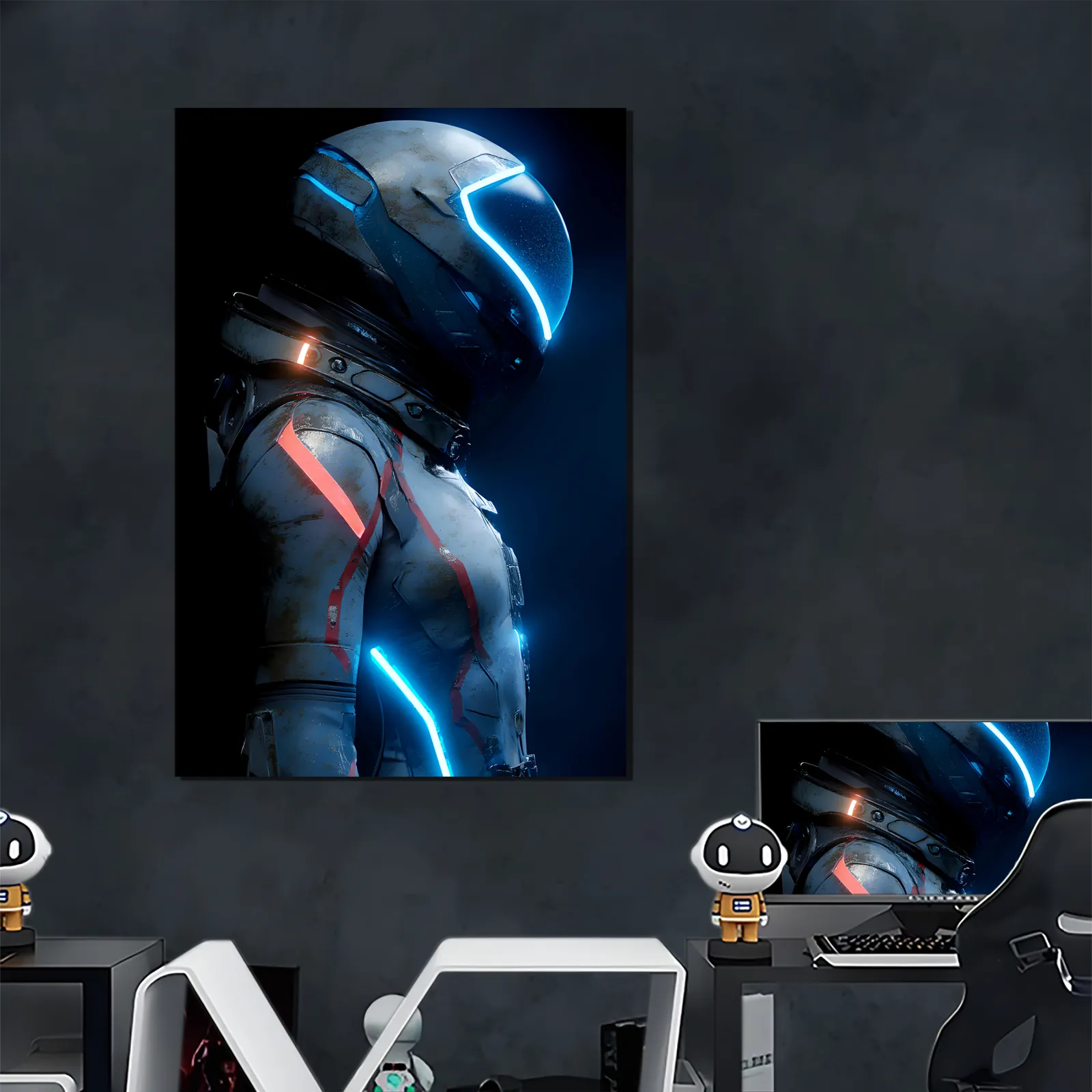العلم وراء إشارات النيون وخلق الأجواء
علم نفس الألوان في إضاءة النيون
الألوان التي نراها في الإضاءة النيونية تلعب في الواقع حيلًا على عقولنا وتؤثر على شعورنا. أظهرت الأبحاث أن الألوان المختلفة تُحدث ردود فعل متنوعة لدى الناس، مما يفسر سبب أهمية الألوان بالنسبة لحالتنا النفسية. خذ على سبيل المثال اللون الأصفر، فهو يجعل معظم الناس يفكرون في أشعة الشمس والسعادة. أما اللون الأزرق فمن المعروف أنه يمنح الناس إحساسًا بالسلام والاسترخاء. تدرك الشركات الذكية كيف تعمل هذه الأمور وتختر بعناية ألوان النيون التي تستخدمها لتتماشى مع نوع الأجواء التي تريد أن يشعر بها العملاء عند دخولهم إلى أماكنهم. قد تختار مطعمًا الأحمر الدافئ لتحفيز الشهية، بينما من المحتمل أن تختار سبا الأزرق البارد لمساعدة الضيوف على الاسترخاء.
تأتي اللافتات النيونية بألوان مختلفة، وهذه الألوان تؤثر فعليًا على شعور الناس عندما يروها، مما يُؤثر على تصور العملاء لمكانٍ ما وطريقة تفاعلهم معه. خذ على سبيل المثال المطاعم. يفضّل العديد منها استخدام النيون البرتقالي أو الأحمر لأن هذه الألوان تُثير الشهية وتنشئ جوًا دافئًا وجذابًا. من ناحية أخرى، تميل صالونات التدليك (المنتجعات الصحية) إلى استخدام الإضاءة النيونية الخضراء نظرًا لارتباط اللون الأخضر بالاسترخاء والشعور بالانتعاش بعد جلسة تدليك أو علاج. عندما يُتقن أصحاب الأعمال هذا الجانب النفسي للألوان، تتحول لافتاتهم النيونية من مجرد زينة إلى عامل فعّال يعمل في الخلفية لتشكيل الانطباع الأول والذكرى التي يحتفظ بها العملاء المحتملين.
لقد أصبحت الشركات في جميع أنحاء المدينة ذكية حقًا في استخدام علم النفس اللوني مع الإشارات النيونية لخلق المزاج المناسب. عادةً ما تختار المقاهي والمتاجر الصغيرة ألوانًا نيونية معينة لأنها تدرك أن هذه الدرجات لا تبدو جيدة فحسب، بل تجذب الناس وتحافظ على اهتمامهم. خذ ذلك المكان الصغير لبيع القهوة في شارع المين، على سبيل المثال. لقد اختاروا ألوانًا نيونية باستيلية خفيفة بدلًا من الألوان الزاهية، مما خلق جوًا مهدئًا يجعل العملاء يرغبون في البقاء وتناول مشروباتهم مع التحدث. لا يفكر معظم الناس في الطريقة التي تعمل بها الألوان في الإضاءة النيونية، لكنها تحدث فرقًا كبيرًا عند محاولة إنشاء جو مناسب. هذا هو السبب في أن العديد من رجال الأعمال يتجهون إلى استخدام النيون في الآونة الأخيرة، سواءً في واجهات المحلات أو حتى الرئيسية مشاريع الديكور مؤخرًا.
اللعبه الظلية والإدراك العميق
لدى أضواء النيون طريقة رائعة تجعل الظلال تتحرك وترقص، مما يساعد فعليًا الأشخاص على إدراك العمق بشكل أفضل داخل أي غرفة. عندما تمر هذه الأضواء عبر الأجسام، فإنها تخلق طبقات متعددة من التأثيرات البصرية التي تغيّر الطريقة التي نختبر بها المساحة نفسها. الظلال الناتجة عن الإضاءة النيونية تبرز التفاصيل الموجودة في الجدران والأثاث، بل وكل شيء ذو قوام تقريبًا. يميل الأشخاص إلى ملاحظة أشياء لم يكونوا لينتبهوا إليها في حال سيرهم عبر مناطق مضاءة بشكل عادي. ما يجعل هذا الأمر رائعًا هو الطريقة البسيطة التي تتحول بها المساحات العادية تمامًا تحت تأثير ضوء النيون. فجأة تصبح الممرات العادية مساحات تستحق الاستكشاف فقط بفضل تلك الأنماط الظلالية المثيرة التي تتحرك على الأسطح.
يواصل الباحثون في مجال العمارة اكتشاف وجود علاقة معقدة بين الضوء والظلال وطريقة إدراك الأشخاص للمساحات التي يعيشون فيها. ما نعرفه من أعمالهم هو أن اللعب بذكاء مع الظلال يمكن أن يغير بشكل حقيقي إدراكنا لمساحة معينة - مما يجعل الغرف تبدو أكبر مما هي عليه، أو تعطيها عمقًا أكبر، أو تلفت الانتباه إلى مناطق محددة داخل المكان. خذ على سبيل المثال الإضاءة النيونية. هذه الأنواع من الإضاءة لا تتميز باللمعان فحسب، بل تساعد أيضًا في تحديد الأشكال وإبراز التفاصيل التي ربما كانت ستبقى غير ملحوظة. لقد بدأ المهندسون المعماريون ومصممو الديكور الداخلي يرون في الإضاءة النيونية شيئًا مميزًا للغاية من حيث إعادة تخيل طريقة بناءنا وتجربتنا للمساحات.
تُعتبر مزيج العروض الخافتة مع الإضاءة النيونية مثالية في مختلف الأماكن، سواء في المتاجر أو غرف المعيشة. على سبيل المثال، تستخدم العديد من المتاجر والمقاهي ظلال الإضاءة النيونية لجعل بعض المنتجات بارزة وجذب نظرات الزوار أثناء مرورهم. في المنازل، يضع الناس لافتات نيونية في مواقع مُختارة بعناية داخل بيوتهم. يعلق البعض هذه اللافتات بالقرب من القطع الفنية لتعطيها مظهراً أكثر دراماتيكية، بينما يستخدمها آخرون لتحديد مناطق مختلفة ضمن المساحات الكبيرة المفتوحة التي تخلو من الجدران، وهناك من يرغب فقط بإضفاء بعض العمق والاهتمام على الجدران العادية. عندما تُنفذ بعناية، فإن هذه العناصر تحول الأماكن العادية إلى أماكن خاصة تشعر كل من يدخلها بالترحيب والحيوية.
تطبيقات الإشارات النيونية لخلق أجواء مميزة
الفضاءات التجارية: البيع بالتجزئة والضيافة
أصبحت اللافتات النيونية مصدر تغيير حقيقي للشركات التي تسعى لتعزيز صورتها التجارية وإنشاء الأجواء المناسبة في المناطق التجارية، خاصة في المتاجر والمطاعم. لا تقتصر وظيفة هذه اللافتات المتوهجة على مجرد الزينة على الجدران، بل تعمل كمصابيح تجذب انتباه المارة أمام واجهات المتاجر. فعلى سبيل المثال، في بهوات الفنادق أو الحانات غير الرسمية، يساهم الإضاءة النيونية في خلق أجواء مرحبة تحفز الزبائن على العودة مجددًا. يشير العديد من أصحاب الأعمال إلى ملاحظتهم زيادة في عدد الزوار بعد تركيب هذه الإضاءة الجذابة، كما يميل العملاء إلى البقاء لفترة أطول أيضًا. إن الألوان الزاهية وأنماط الحركة في العروض النيونية الحديثة تبدو ساحرة في جذب الحشود وخلق تجارب لا تُنسى.
الاستخدام المنزلي: غرف النوم ومناطق المعيشة
أصبحت اللافتات النيونية في منازل الناس مصدر جذب كبير هذه الأيام، حيث تتيح لهم التعبير عن شخصياتهم في حين تحسين مظهر المسكن. يضعها الناس في غرف النوم وغرف المعيشة وأحيانًا حتى في المطابخ. تضيف هذه اللافتات المضيئة شيئًا خاصًا إلى الغرف العادية، وتحولها إلى أماكن تشعرهم بأنها ملكهم حقًا. يختار معظم الناس عبارات تحفزهم، أو أشكالًا مخصصة يحبونها، أو ألوانًا زاهية تجعل الغرفة ملفتة للنظر. وقد شهدت سوق اللافتات النيونية محلية الصنع نموًا هائلًا مؤخرًا، لذا يمكن لمالكي المنازل الآن تعديل التصاميم تمامًا حسب رغبتهم. وهذا يتماشى مع ما يريده المستهلكون في الوقت الحالي - منتجات تتماشى تمامًا مع أسلوبهم الشخصي. وتؤكد الأرقام البيعية هذا أيضًا، حيث تظهر قفزة كبيرة في عدد الأشخاص الذين يشترون أشياءً نيونية لمنازلهم. وعندما يقوم أحدهم بصنع لافتة خاصة به، فإنه يخلق جوًا يتناسب حقًا مع حالته المزاجية في ذلك الوقت، مما يفسر سبب بدء العديد من الأسر مؤخرًا في إضاءة منازلهم بالنيون.
التخصيص: تصميم أجواء فريدة من خلال تصاميم النيون
اقتباسات وم Symbols شخصية
اللافتات النيونية المصنوعة خصيصًا لشخص ما تضيف شيئًا لا تستطيع اللافتات القياسية توفيره، ألا وهو الجانب العاطفي. يحب الناس إضافة لمساتهم الخاصة على غرفهم من خلال هذه التصاميم المخصصة. فكّر في الأمر بهذه الطريقة: يُبدع الناس في استخدام عبارات يؤمنون بها، أو بأسماء أطفالهم مكتوبة بأحرف مضيئة، أو برموز تحمل معاني خاصة لهم. يختار معظم الأشخاص مواضيع تلامس قلوبهم. تنتشر حاليًا العبارات التحفيزية، وكذلك تلك العبارات الجذابة من الأغاني أو الأفلام المفضلة التي تبقى عالقة في الأذهان إلى الأبد. وفي النهاية، تصبح هذه القطع الصغيرة من الضوء جزءًا من ذكريات العائلة، أو تذكيرًا بأوقات جميلة، أو رمزًا لحظات مهمة في الحياة نود أن نحتفظ بها دائمًا بقربنا.
ميزة تغيير اللون ديناميكيًا
أصبحت إشارات النيون المتغيرة اللون تُغيّر بالكامل طريقة نظر الناس إلى المساحات الداخلية في الوقت الحالي. فهي تتيح تغيير جو وانطباع الغرفة تقريبًا بشكل فوري. في الواقع، تعمل معظمها بتقنية RGB، مما يسمح لها بالتنقل بين مختلف الألوان حسب الحاجة. فكّر في الأمر بهذه الطريقة: صديقتي وضعت واحدة في مكتبها المنزلي. خلال ساعات العمل، تُنير بلون أزرق خافت يساعدها على التركيز، ولكن عندما تعمل على مشاريع إبداعية في أوقات متأخرة من الليل، تُغيّر اللون إلى الأحمر الزاهي الذي يحفّز دمها ويُطلق العنان لأفكارها. إن هذه المرونة رائعة حقًا.
الكفاءة في استخدام الطاقة والمتانة في تصميم الأجواء
استهلاك منخفض للطاقة، تأثير بصري عالٍ
أحدث التطورات في تكنولوجيا الإشارات النيونية قللت من متطلبات الطاقة بشكل ملحوظ مع الحفاظ على تلك الصور الجذابة التي اعتدنا عليها ونحبها. خذ على سبيل المثال الإضاءة النيونية LED، فهي تستهلك حوالي 80% أقل من الطاقة مقارنة بالإشارات النيونية التقليدية. وماذا يعني ذلك؟ عروضًا أكثر إشراقًا دون استهلاك مفرط للطاقة الكهربائية. وتوفّر الشركات المال شهريًا على فواتير الكهرباء، وهو أمر دائمًا ما يُرحّب به. علاوةً على ذلك، تترك هذه الإشارات تأثيرًا بيئيًا أقل لأنها لا تستهلك الكثير من الطاقة الناتجة عن الوقود الأحفوري. نحن نشهد تحولًا متزايدًا من قبل المتاجر إلى هذه الخيارات ذات الاستهلاك المنخفض للطاقة، إذ يرغب العملاء في أن تُظهر الشركات اهتمامها بالبيئة، مع توقّعهم في الوقت ذاته لواجهات متاجر مبهرجة تجذب الانتباه أثناء سيرهم في الشارع.
متانة لتعزيز الأجواء باستمرار
تتميز الإشارات النيونية الحديثة بعمر افتراضي أطول هذه الأيام لأن الشركات المصنعة تستخدم مواد أفضل وتقنيات حديثة أثناء تصنيعها. خذ على سبيل المثال الإضاءة النيونية LED، إذ يمكن أن تستمر حوالي 50 ألف ساعة قبل أن تحتاج إلى استبدال، وهو ما يتفوق كثيراً على لوحات النيون التقليدية. ماذا يعني هذا لأصحاب الأعمال؟ إنفاق أقل على الإصلاحات واستبدال المصابيح مع مرور الوقت. يجد معظم التجار أن الاستثمار في إضاءة متينة يعود عليهم بفوائد على المدى الطويل، حيث لا يضطرون للقلق بشأن تآكل مظهر اللوحة أو حدوث وميض بعد بضع سنوات فقط من الاستخدام.

الاتجاهات المبتكرة التي تعيد تحديد جو الإضاءة النيونية
تكامل المنزل الذكي والتحكم الصوتي
يُحدث الجمع بين التكنولوجيا الذكية والإشارات النيونية تغييرًا جذريًا في كيفية إنشاء الأجواء باستخدام الإضاءة. تأتي هذه الشاشات النيونية الحديثة مزودة بخصائص يمكن للأشخاص تعديلها وتخصيصها مباشرةً من هواتفهم أو حتى من خلال التحدث إلى أجهزتهم. هل ترغب في تخفيف الإضاءة؟ أو تغيير الألوان؟ أو تبديل الأنماط؟ كل هذا ممكن وبكل سهولة. على سبيل المثال في البيئات السكنية، بدأ الكثير من الناس في التحدث إلى إضاءتهم بدلًا من استخدام المفاتيح. ما عليك سوى قول شيء مثل "مرحباً أليكسا، اجعل غرفة المعيشة تشعر بالهدوء"، وفورًا تبدأ الإضاءة النيونية بنشر ألوان زرقاء وبنفسجية ناعمة على الجدران، لتخلق بالضبط تلك الأجواء المرغوبة في منازلهم المتصلة.
بدائل النيون الصديقة للبيئة
بدأ الاهتمام بالاستدامة يلعب دورًا أكبر في طريقة تصنيع إشارات النيون هذه الأيام، حيث بدأ الناس يوجهون اهتمامهم نحو الخيارات الأكثر صداقة للبيئة. العديد من مصنعي الإشارات يتحولون الآن إلى الإضاءة LED بدلًا من أنابيب النيون التقليدية. تستخدم مصابيح LED طاقة أقل بكثير ولا تحتوي على تلك الغازات الخطرة الموجودة في إشارات النيون التقليدية. لاحظنا هذا التحول في الصناعة مؤخرًا. كما أن الأشخاص الذين يعملون على تزيين المساحات الخاصة بهم يبدون اهتمامًا متزايدًا بما هو مفيد للبيئة أيضًا. خاصةً يرغب أصحاب المطاعم والبارات في الحصول على ذلك المظهر الكلاسيكي الجذاب دون تحمل الأثر البيئي المرافق. لقد غيرت الوعودة حول البصمة الكربونية بالفعل الطريقة التي تتخذ بها الشركات قراراتها بشأن الإشارات في الوقت الحالي.
قسم الأسئلة الشائعة
ما المشاعر التي يمكن أن تثيرها ألوان النيون المختلفة؟
يمكن أن تثير ألوان النيون المختلفة مشاعر متنوعة — فالأصفر يرتبط بالدفء، والبرتقالي يحفز الشهية، والأزرق يرتبط بالهدوء، والأخضر يرتبط بالسكينة.
كيف تعزز إضاءة النيون إدراك العمق؟
تُنشئ أضواء النيون لعبة من الظلال تضيف تعقيداً وحيويةً لمساحة معينة، مما يعزز إدراك العمق ويجذب للاستكشاف.
لماذا أصبحت لافتات النيون شائعة في البيئات السكنية؟
تسمح لافتات النيون للأفراد بالتعبير عن أسلوبهم الشخصي وتعزز ديكور المنزل، حيث تخلق أماكن خاصة تحمل عبارات تحفيزية وألواناً نابضة بالحياة.
ما تأثير لافتات النيون على استهلاك الطاقة والاستدامة؟
تستهلك لافتات النيون الحديثة، وخاصةً تلك المصنوعة من الـ LED طاقةً أقل بكثير، وتدعم الممارسات التجارية المستدامة، وتقلل البصمة الكربونية.
ما الفائدة من الدمج الذكي في لافتات النيون؟
تقدم التكامل الذكي ميزات إضاءة تفاعلية وقابلة للتخصيص يتم التحكم بها عبر التطبيقات أو الأوامر الصوتية، مما يعزز تجربة المستخدم في الديكور.
كيف تستفيد البيئة من البدائل الخضراء للنيون؟
تستخدم البدائل الخضراء للنيون موادًا موفرة للطاقة مثل مصابيح LED، مما يقلل الضرر البيئي ويقدم متانة أعلى.


